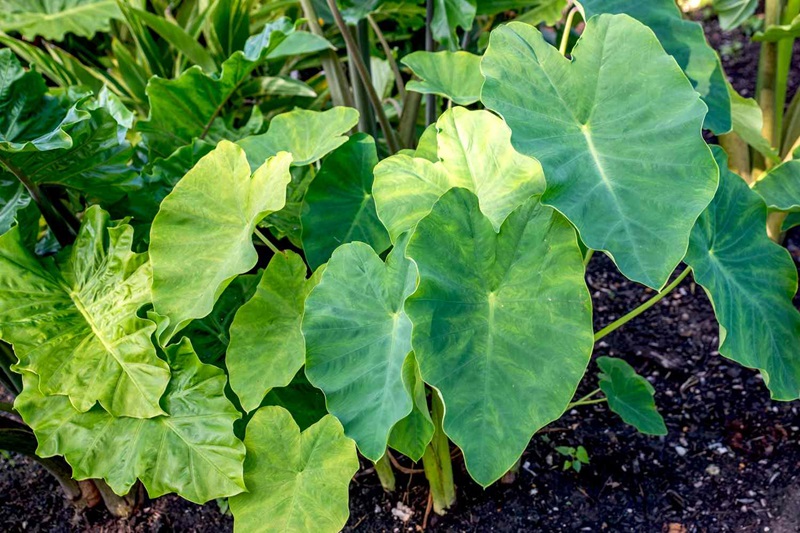Troubleshooting Elephant Ear Plants: Addressing 5 Common Issues for Lush Growth

The allure of elephant ear plants lies in their spectacular, oversized leaves that bring a touch of the tropics to any garden. However, cultivating these stunning botanical wonders can sometimes be challenging, as they are not immune to a variety of issues that can impede their growth and vitality. In this comprehensive guide, we will delve into five common problems encountered by elephant ear plant enthusiasts and explore effective solutions for each concern.
1. Yellowing Leaves – A Sign of Nutrient Deficiency
Yellowing leaves on an elephant ear plant is often indicative of nutrient deficiencies, primarily a lack of nitrogen, a crucial element for robust leaf development. To address this issue, it’s essential to incorporate a balanced fertiliser with higher nitrogen content into your plant care routine. Applying this fertiliser during the growing season will supply the necessary nutrients, revitalising the leaves and restoring their vibrant green hue. Additionally, consider incorporating organic matter into the soil, promoting a healthier nutrient balance and overall plant well-being.
In the quest for lush growth, understanding the specific nutrient requirements of an elephant ear plant is paramount. While nitrogen plays a pivotal role in leaf development, other essential nutrients, such as phosphorus and potassium, must also be present in adequate amounts. Regular soil testing can help you pinpoint nutrient deficiencies and tailor your fertiliser application accordingly.
2. Overwatering Woes – Balancing Moisture for Healthy Growth
Overwatering poses a common challenge for elephant ear plant enthusiasts, as these plants, while appreciating moist soil, can suffer from root rot and other complications when subjected to excessive water. Achieving the right balance is crucial, and it starts with ensuring proper drainage in the planting area. Integrate organic matter into the soil to enhance its water-holding capacity while maintaining adequate drainage. Furthermore, allow the soil to dry slightly between waterings, adjusting your watering schedule based on factors such as climate and soil type. Implementing a layer of mulch around the plant’s base can also help regulate soil moisture, providing a more stable environment for your elephant ear plants to flourish.
Understanding the specific water needs of your elephant ear plants is key to preventing overwatering. Factors such as humidity, temperature, and the size of the plant all play a role in determining the frequency and quantity of water required. Consider using a moisture meter to gauge soil moisture levels accurately. If your region experiences heavy rainfall or prolonged periods of dampness, take proactive measures to protect your plants by providing proper drainage and elevating containers to prevent waterlogging.
3. Sunburned Leaves – Finding the Right Balance of Light
Elephant ear plants thrive in partial to full shade, making them susceptible to sunburn when exposed to direct sunlight for extended periods. Sunburned leaves often display brown, crispy edges, detracting from the plant’s overall beauty. To mitigate this issue, strategic placement is crucial. Choose a location with filtered sunlight or partial shade, shielding your plants from the harsh midday sun. If your garden receives intense sunlight, consider using shade cloth to provide the necessary protection without compromising the plant’s health.
Understanding the nuances of sunlight exposure is vital for cultivating healthy and vibrant elephant ear plants.
Different varieties may have varying tolerance levels to sunlight, so research the specific requirements of your plant. Observing the sunlight patterns in your garden throughout the day will help you identify the ideal planting spots. Additionally, be attentive to seasonal changes, as the angle and intensity of sunlight can vary. By creating a well-shaded environment and being mindful of sunlight exposure, you can protect your elephant ear plants from the perils of sunburn, ensuring they flourish with lush, unblemished foliage.
4. Pests And Their Sneaky Onslaught – Identifying And Eliminating Invaders
Pests can pose a significant threat to the health of elephant ear plants, causing damage to leaves and impeding their overall growth. Common invaders include spider mites, aphids, and scale insects, which can multiply rapidly if left unchecked. Regularly inspect your plants for signs of infestation, such as discoloured or distorted leaves. Introducing natural predators, such as ladybugs, can help maintain a balanced ecosystem in your garden, providing an effective and environmentally friendly solution to pest control.
Vigilance and early detection are paramount when it comes to managing pest issues. Regularly inspect the undersides of leaves, where pests often hide, and promptly address any signs of infestation. Insecticidal soap or neem oil can be effective in controlling pests without harming the plant. Additionally, consider implementing companion planting techniques, where certain plants are strategically placed to deter pests naturally.
5. Temperature Sensitivity – Navigating the Challenges of Climate
Elephant ear plants are native to warm and tropical climates, making them susceptible to damage from cold temperatures. Frost, in particular, can cause irreversible harm, leading to wilting and browning of leaves. If you reside in a region with colder winters, it’s crucial to take preventive measures to protect your plants. Growing elephant ear plants in containers provides the flexibility to move them indoors during colder months, shielding them from harsh weather conditions.
Understanding the temperature preferences of your elephant ear plants is essential for their long-term health and survival. While some varieties may exhibit greater cold tolerance, others may be more sensitive. Consider selecting cold-hardy cultivars if you live in a region with unpredictable weather patterns. Applying a layer of mulch around the plant’s base can also insulate the roots, offering additional protection during extreme temperatures.
Conclusion
Cultivating lush and healthy elephant ear plants requires a nuanced understanding of their specific needs and a proactive approach to addressing potential issues. Remember, a little care and attention go a long way in maintaining the beauty and vitality of these stunning botanical wonders, rewarding you with a garden adorned with vibrant, flourishing foliage.